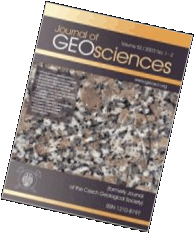 Export to Mendeley
Export to MendeleyOriginal Paper
Compositional variation in tourmaline from tourmalinite and quartz segregations at Pernštejn near Nedvědice (Svratka Unit, western Moravia, Czech Republic)
Journal of the Czech Geological Society, volume 43 (1998), issue 1-2, 53 - 58
The Pernštejn tourmalinite is situated in the southern part of the Svratka Unit near the border with Moldanubicum. It underwent a retrogressive low-to-medium grade regional metamorphism which produced quartz segregations within the tourmalinite. Fine-grained tourmalinite dominantly consits of quartz and tourmaline (dravite-schorl). The tourmaline is elongated, euhedral to subhedral grains are typically < 0.5 mm in size. Tourmaline (dravite-schorl) from quartz segregations forms euhedral grains, from 0.5 to 10 mm in size, locally associated with kyanite, andalusite, muscovite, apatite and accessory rutile. There is only a negligible difference between tourmaline from tourmalinite and quartz segregations. Tourmaline of both paragenetic types is characterized by moderate to high vacancies in the X-site, up to 45 at.%, and moderate to high F contents varying from 0.32 to 0.56 apfu. It also exhibits Fe/Mg ratios and Al contents typical for tourmaline in metapelites and metapsammites with an Al-saturating phase (eg kyanite, andalusite).
Formation of the quartz segregations with coarse-grained tourmaline and kyanite began during a retrogressive kyanite grade metamorphic event at P > 3-4 kbar and T > 400-500 °C through the kyanite-andalusite transition to the andalusite grade. The presence of tourmaline as the only ferro-magnesium mineral and the presence of Si-, Al- and Ti-saturating phases, ie quartz, kyanite/andalusite and rutile, respectively, buffered these elements during the mobilization process which produced the quartz segregations.
Webdesign inspired by aTeo. Hosted at the server of the Institute of Petrology and Structural Geology, Charles University, Prague.
ISSN: 1803-1943 (online), 1802-6222 (print)
email: jgeosci(at)jgeosci.org


IF (WoS, 2024): 1.3
5 YEAR IF (WoS, 2024): 1.4
Policy: Open Access
ISSN: 1802-6222
E-ISSN: 1803-1943